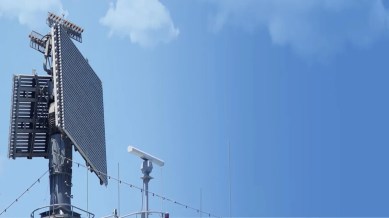Stay updated with the latest - Click here to follow us on Instagram
After Operation Sindoor, Army to boost drone shield with new radars along northern and western borders
The new radar systems that the Army plans to procure are designed to detect, track and engage aerial objects with a low radar cross-section (RCS), which makes them harder to spot.

With Pakistan managing to breach Indian airspace with swarms of drones, including camouflaged surveillance and attack UAVs, during the hostilities that followed Operation Sindoor, the Indian Army is preparing to plug gaps in its air surveillance network along the northern and western borders with advanced radars, The Indian Express has learned.
The new radar systems that the Army plans to procure are designed to detect, track and engage aerial objects with a low radar cross-section (RCS), which makes them harder to spot. According to sources, these systems will be integrated into the Army’s Akashteer air defence network, giving battlefield commanders sharper eyes in the sky and faster responses against hostile drones and other aerial threats.
monthly limit of free stories.
with an Express account.
In two separate Request for Information (RFI) — the formal process for gathering inputs from potential suppliers — the Army has sought to procure up to 45 Low Level Light Weight Radars (Enhanced) (LLLR-E) and up to 48 Air Defence Fire Control Radar-Drone Detectors (ADFCR-DD). In a separate Request for Proposal (RFP), the Army has also called for 10 Low Level Light Weight Radars (Improved) (LLLR-I]) a surveillance system designed to scan airspace, detect and track targets (including those with very low RCS), and prioritise them based on threat.
The LLLR-I will be a three-dimensional (3D) Active Electronically Scanned Array (AESA) radar with a Commander’s Display Unit, Target Designation System, and integral power supply. It must work across terrains — from mountains and high-altitude areas to deserts and coasts — and be able to detect all aerial targets within a 50-km range while tracking more than 100 targets at once.
The LLLR-E has similar features but adds an Electro-Optical Tracking System (EOTS) and a passive radio-frequency detection system, enabling it to pick up signals from low-RCS drones, including swarms, and transmit target data to weapon systemsup to 10 km away. The EOTS will allow tracking both day and night, independently or cued by radar.
The ADFCR-DD, meanwhile, will combine a search radar, track radar, fire control systems, and Identification Friend-or-Foe (IFF) capability, all mounted on a single vehicle. It will control the fire of at least two L/70 or successor air defence guns and feed target data to Very Short Range Air Defence Systems (VSHORADS), which are designed to intercept threats at close range.
The Army’s RFI notes that during Operation Sindoor, Pakistan relied heavily on drone swarms for surveillance and for attempting to damage both civilian and defence installations. Existing air defence guns like the L/70, ZU 28 and Schilka performed “exceptionally well” against these threats, but the Army maintains that pairing them with modern fire control radars, capable of detecting, identifying, classifying, and controlling weapon systems to target even the smallest surveillance and attack drones, would make neutralising such threats far more effective.
According to the Army, the new fire control systems should be able to process target data from multiple radars and electro-optical systems, compute firing solutions, and relay this information both to gun systems and to shoulder-fired air defence missiles.